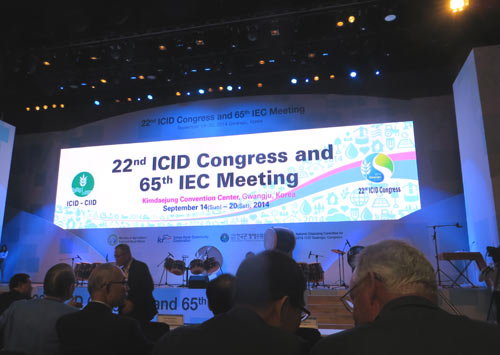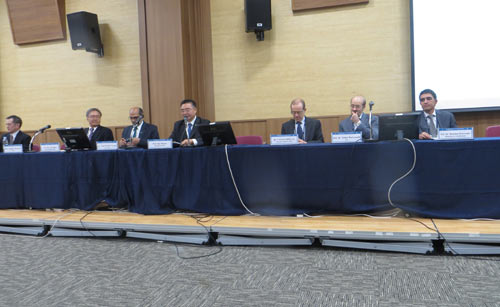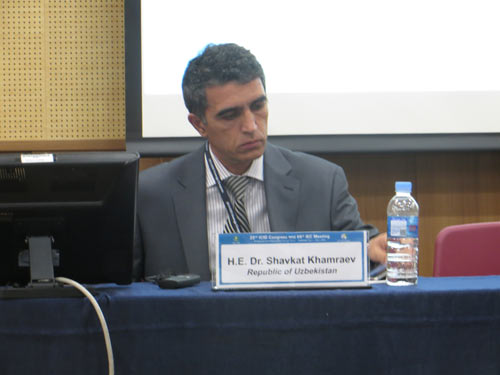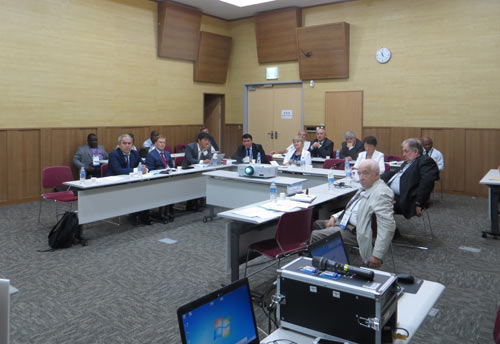THE 22ND CONGRESS AND 65TH MEETING OF INTERNATIONAL EXECUTIVE COMMITTEE OF THE INTERNATIONAL COMMISSION ON IRRIGATION AND DRAINAGE
Gwangju, Republic of Korea, September 13-20, 2014
The 22nd ICID Congress, where more than 1,700 delegates from 61 countries participated, was opened with a remarkable performance and greetings - video mes¬sage from Ms. Park, the President of South Korea, the Mayor of Gwangju, and Mr. Lee Sang-Mu, the President of Korea Rural Community Corporation (KRC) and the Chairman of the National Committee on Irrigation and Drainage.

The President of ICID, Dr. Gao Zhanyi made a great speech. He noted the significance of holding this Congress in Korea, which is fairly reputed to be a leader in innovative process of the world’s irrigation. Korea has made a significant progress in rural area, which effectively combines agro-industrial system fitted into natural landscape. For the last 5 years, the Green Development encouraged the symbiosis of human activity and the natural processes. Particular attention is paid to application of SCADA system and “Smart Water Management”, which ensures thorough monitoring of water allocation and water demands, as well as climate change.
The President Gao noted achievements of ICID for the past 3 years: organization of the First World Irrigation Forum; a newly established prize for outstanding contributions to the field of irrigation and drainage; significant practical improvement of information network and ICID headquarters in Delhi that allowed to extending the usage of ICID database. A number of African countries joined the ICID network due to a pressing need for development of irrigation in order to solve problems of droughts and survival in general. A campaign for inventory on World Heritage Irrigation Structures started.
Deputy Minister of China Mr. Lee Guoying while greeting the participants of the Congress, noted the significance of ICID activity in the popularization of best practices and knowledge, and principles of efficient management of irrigation resources as well. China liberally shares its achievements. 62 millions hectares of irrigated land are essential in food security of the country. In 2013 China organized a workshop on the sharing of best practices for 20 young specialists from developing countries (10 people represented Central Asia). Now China begins the second stage of water sector and irrigation improvement in order to increase the potential of water use without changes in water diversions.
The Ceremony “Uniting Rivers Waters” of eight rivers in the World such as Amazon, Colorado, Rhine, Nile, Euphrates, Ganges, Yellow River and Youngsan River, was symbolic of united world water problems an d cooperation needed for the successful development of efficient water management.
After the gala opening ceremony of the Congress, an exhibition was launched. There were exhibits presenting Korean irrigation industry, mainly related to automation and IT.
September 15 was marked by a ministerial level meeting chaired by Mr. Lee Sang-Mu, the President of Korea Rural Community Corporation (KRC). Ministers of such countries as Thailand, Mongolia, Uganda, and Uzbekistan were invited to the meeting, devoted to the importance of irrigation in problem solutions in the countries and particularly in rural areas. Mr. Sang-Mu said that Korean agricultural development is based on private and public partnership; repeated technology renovation towards bio clean farming; development of fishery using the irrigation structures, while focusing on maintenance of canals and other structures. Using Holland experience they reclaimed the delta Sostanghel from the sea. The comprehensive agricultural development follows the so-called Saemaul, a new rural movement, which combines the development of bio-industry. This movement implies the integration of rural development, changes in mentality and “top-down” and “bottom-up” approaches.

Mr. Shavkat Khamraev, Deputy Minister of Agriculture and Water Resources of the Republic of Uzbekistan, mentioned that Uzbekistan, while reforming its agrarian production, replaced the state and collective farms with leasing farms, which are the biggest in the Central Asia (40-150 hectares for seed and cotton, 5-25 hectares for fruit, vegetables and vineyards). Diversification of crop patterns has led to reduction of cotton field areas, from 2 to 1.25 million hectares. Restructuring of agriculture is correspondingly accompanied by changes in water sector’s structure through hydrographization: establishment of basin authorities and more than 1,000 WUAs. Improvement of the water sector and land reclamation with decrease of water diversion volume from 65 to 51 km3 ensured food security for all food items, except for meat and vegetables.

After the discussion, the President Mu concluded the meeting having formulated the following needs:
- Comprehensive infrastructure development, including irrigation;
- Sustainable institutional framework, based on partnership of private, public companies and water users, with guaranteed mutual benefits.
- Qualified leaders, looking to the future and understanding the significance of environmental changes.
- Stability in relationship and flexibility to changing conditions. Livelihoods in rural area
The main topics covered at the Congress were: topic 58 “How Irrigation and Drainage play an important role in Climate Change Adaptation?”; and, topic 59 “How do Irrigation and Drainage interventions secure food production and livelihood for rural community?”
As far, as it is known, climate change increases the stress in complex and interrelated agricultural development. Irrigation allows reduction of negative impact and subsequent hazards as well, e.g. mitigated floods and droughts. The adaptation strategy is impossible without irrigation and drainage. A negative impact of climate change on harvest becomes more frequent than positive influence of the temperature rise. The problem becomes more complicated in less developed regions with water stress, where the gist of the problem is not made clear and the extent of extreme changes is significantly higher. Nevertheless, irrigation and drainage allows setting countermeasures, based on the past and current conditions and the methodological innovations and modern technology. The global food security is actually guaranteed only by irrigation effects. Moreover, irrigation is the basis of livelihoods in rural area being one of the main elements of economical activity. It is irrigation and drainage that contribute to security of livelihood and protection of rural population from poverty and migration to megalopolises. The essential elements of rural development are the combined use of clean and return waters in irrigation systems for farms and the nature. It is significant to consider the role of rural community in water governance and hydrostructure operation. The main ways to enhance irrigation efficiency are automation and water rotation; water scheduling; accurate measurements of water delivery and use. Modernization of irrigation and drainage facilities is the essential part of water conservation, and water and land productivity improvement. Adoption of new technologies along with implementation of Integrated Water Resources Management (IWRM) can contribute to these goals. 290 reports and posters from 37 countries were presented on these two topics.
During the final session of the Congress on September 16, Dr. Khamraev made a speech about the progress in Uzbekistan in irrigation. He emphasized: “Under existing conditions of water shortage, Uzbekistan is still a leader in the adoption of innovative technologies and constant rationalization of water use in irrigated land. The Republic was the first to develop and implement IWRM on example of the Fergana valley that allowed using all new methods of water management to improve institutional structure and infrastructure. As a result, we managed to save 200 million m3 of water per year on more than 130 thousand hectares. As a follow-up, Uzbekistan implements IWRM in 7 provinces within almost 0.5 million hectares of irrigated area. IWRM implementation is accompanied with development and application of automated control systems; water accounting along the main canals and the Syrdarya River; development of agricultural extension services, which fits very well the current network of Water consumer associations (the number exceeds 1,000)
Improvement of irrigated agriculture runs simultaneously with restructuring of agricultural enterprises, widespread introduction of market farming methods, and improvement of the whole agricultural infrastructure, including irrigated agriculture. Therefore, the Republic pays much attention to diversification of agricultural production. Instead of moisture-loving crops, such as rice, cotton and alfalfa, production of less water consuming crops – grain, melons, fruits, vineyards and others - was increased. In comparison with the end of the 80s, when 50% of the total 4 million hectares of irrigated land were under cotton (2 million hectares), today this area is reduced almost twice, exceeding slightly 1 million 250 thousand hectares (30%).”
The participants of the Congress had an opportunity to examine some water infrastructure in the Gwangju province: both large hydraulic structures, and the SCADA and "Smart Water Management" systems. The irrigation district Dondzhan operates 23.1 thousand hectares of irrigated land, of which 18.5 thousand hectares are under rice. Besides, the system supplies water to 2 cities, 22 big villages and 162 rural settlements. The district staff makes 54 people at office and 42 field operators. Besides, during vegetation 42 people are employed. Thus, all system is served by 138 people or 6 people per 1,000 hectares. The system has 172 facilities, including 21 reservoirs with the total volume 279 million m3, 86 pumping stations with discharge of 55.5 m3/s, 16 drainage facilities with the total discharge of 154 m3/s. The system has 1,757 km of irrigation canals modernized on 53% and duel-purpose canals modernized on 13%. Automatic facilities were set up on 22 structures, including 4 pumping stations, 2 control centers and 16 dams. During the period from 2003 to 2006, 3.6 million USD were spent for the installation of central control system; 45 level sensors, mainly ultrasonic ones; and 18 power supply control stations. Measurements and information transmission are carried out with the telecontrol system. For the last 2 years, in addition to this system, 2.6 million USD were spent for the installation of Smart Water Management system, which aims for daily water control depending on weather conditions. It is based on mobile communication and constant analysis of water situation. This project includes more installations, particularly, 138 level sensors and 19 weather stations with automatic information transmission to control station, where the information on situation first is processed, then transmitted to irrigation operator through mobile communication every 10 minutes. It allows an efficient change of operating mode of all structures, depending on weather changes and hydrological parameters. The density of observation points (almost 10 sensors per 1,000 hectares) attracts particular attention.
V.A. Dukhovny, Director of SIC ICWC, participated in the meeting of the Strategic Committee of ICID and the International Executive Committee (IEC) of ICID.
The Strategic Committee discussed the current membership and stated a certain rise of number of active ICID Member States– to 56 – and 40 associated ones, which had a debt on their due fees. It declared reactivation of the National Committees of Madagascar and Tajikistan, and admittance of a new member of the National Committee of Burkina Faso. The committee recommended to all NCIDs to update the status for wider involvement of members into the ICID work, and mobilization of investment to extend activity in each country. As bright examples were presented activity of NCIDs of Korea, Canada and Iran, the first of which got the "Best Performing National Committee" Award. The Strategic Committee approved the structure of the Strategy Theme “Knowledge”, which demonstrated an increase in volume of literature, articles which are available in ICID library now. The committee also submitted the Provision on "World Heritage Irrigation Structures" for approval and appealed to the National Committees to start submitting the list of structures with the service life of more than 100 years, in the single established format.
The IEC made a decision to create a special commission under the chairmanship of the Honorable President Chandra Madramootoo for various awards awarded by ICID, including the Water saving Award and the World Irrigation and Drainage Prize.
Three Vice-presidents of ICID finished the term of office, therefore the competition on their replacement was announced. Five candidates were presented, and the new ones – Dr. Mohamed Wahba (Egypt), Mr. Bong Hoon Lee (Korea) and Dr.Ding Kunlun(China) - were elected.
Elections of the new President of ICID were held as well. The representative of Iran, Mr. Saeed Nairizi, became the 23rd president of ICID, having received the majority of votes.

Prof. V.A. Dukhovny headed the meeting of the Working group on irrigation and drainage in the states under socio-economic transformation. Representatives of Russia, Ukraine, Uzbekistan, Kazakhstan, Tajikistan, Iran, Nigeria, Korea and Japan participated in the meeting. The representative of SIC ICWC Dr. Shuhrat Mukhamedzhanov made a report on “Role and experience of daily irrigation planning water saving”. Representatives of the EECCA countries presented the reports on the condition of irrigation and drainage in their countries, and the pressing development problems. Prof. V.A. Dukhovny summarized common problems which were supported by all participants of the working group:
- agriculture restructuring in the countries under socio-economic transformation has not been completed, consequently the organizational structure and principles of water governance undergo changes, except for Uzbekistan, Tajikistan and Turkmenistan. It seems that there is lack of attention to the issues related to improvement of irrigation, therefore a considerable shrinkage of irrigated area is observed: more than twice in Ukraine, by 2 million hectares in Russia, and by 900 thousand hectares in Kazakhstan;
- the lower level of the water hierarchy is extremely troubled – the former on-farm network of collective and state farms is concentrated mainly in Water Users Associations now. They suffer from poor financial state, personnel deficiency and almost total absence of investments;
- soil salinization;
- “raw” economic mechanism of relationships, particularly between water users and energy and water management organizations;
The representative of Nigeria spoke at the meeting of the Working group, having emphasized the significance of exchange of views with the EECCA countries, as most of recommendations from the developed countries do not take into consideration local peculiarities of the former weak countries.
Prof. V.A. Dukhovny,
Director of SIC ICWC
|